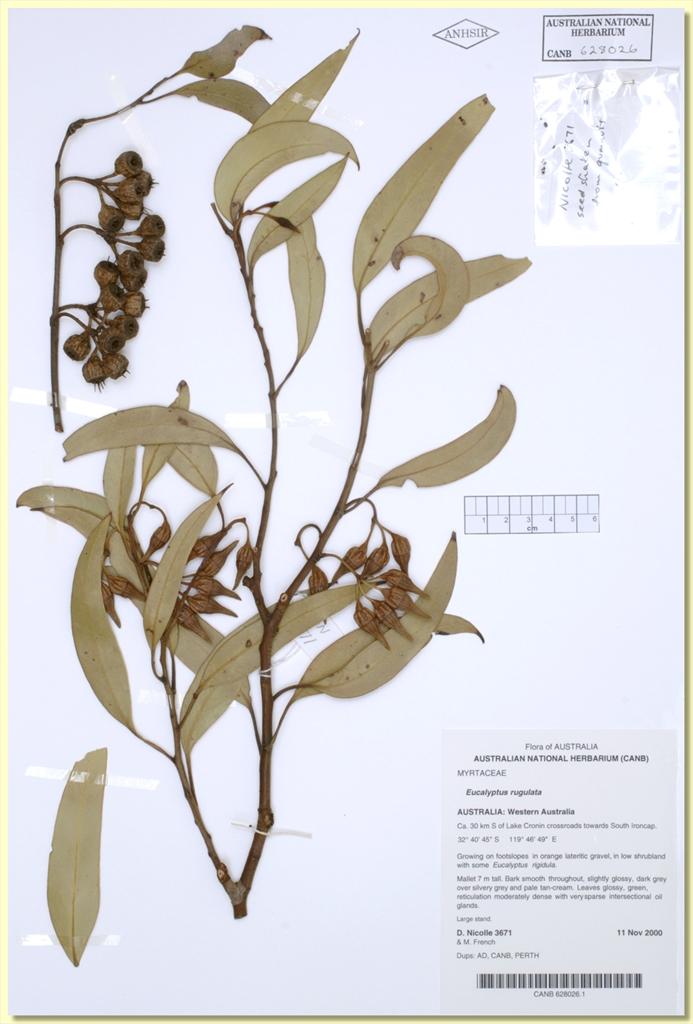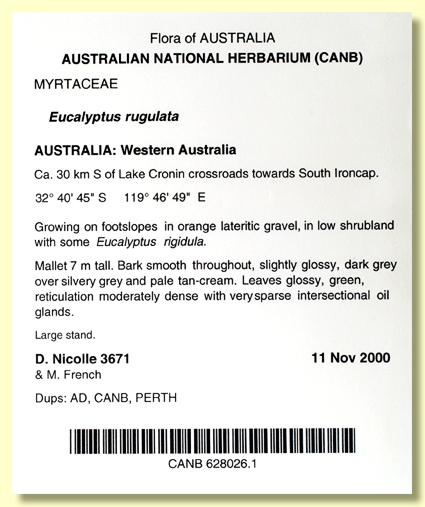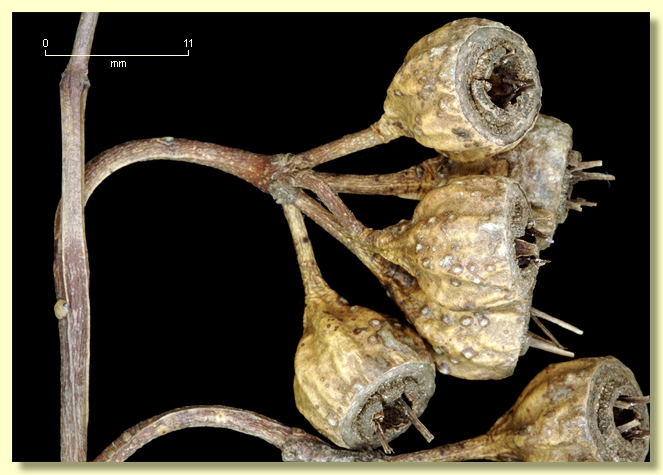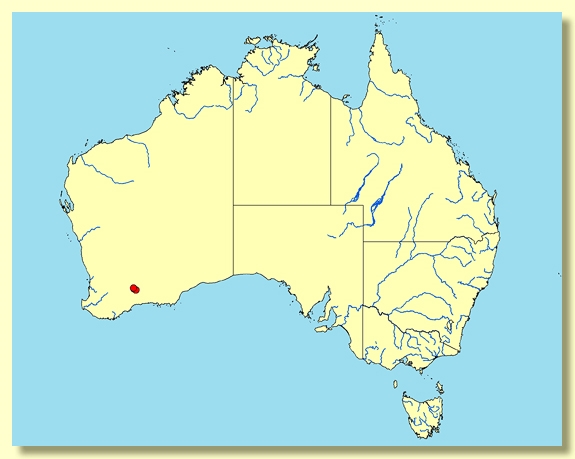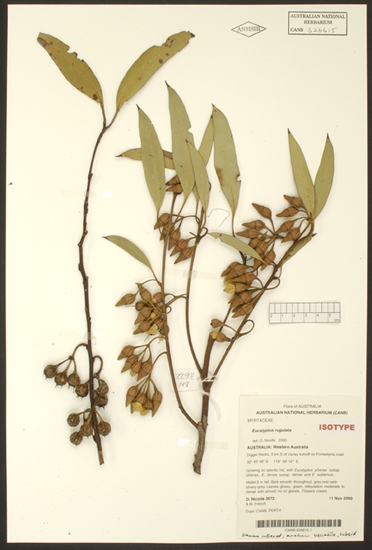Eucalyptus | Symphyomyrtus | Bisectae | Destitutae | Falcatae | Rugatae
Euclid - Online edition
Eucalyptus rugulata
Mallet to 15 m tall. Lignotuber absent.
Bark smooth throughout, grey and silvery grey, shedding in strips.
Branchlets lacking oil glands in the pith.
Juvenile growth (coppice or field seedlings to 50 cm): not seen.
Adult leaves alternate, petioles 1.3–2.5 cm long; blade lanceolate, 7.5–11(14) cm long, 1.3–2.3(2.8) cm wide, base tapering to petiole, margin entire, apex pointed, concolorous, glossy, dark green, side-veins at about 45° to midrib, reticulation moderate to dense, intramarginal vein close to margin, oil glands intersectional, few, or not visible.
Inflorescence axillary unbranched, pendulous, peduncles 1–3.1 cm long, buds 7 per umbel, pedicels 0.7–1.4 cm long. Mature buds elongated-ovoid with conspicuous longitudinal ribs on hypanthium only, 1.5–2.2 cm long, 0.7–0.9 cm wide, scar present, operculum conical, unribbed, stamens all inflexed, anthers cuboid, versatile, dorsifixed, dehiscing by longitudinal slits, style long and straight, stigma blunt, locules 4, the placentae each with 4 vertical rows of ovules. Flowers creamy white.
Fruit on down-turned peduncles, pedicellate (pedicels 0.8–1.3 cm long), truncate-globose, 0.7–1.2 cm long, 0.8–1.2 cm wide, shallowly ribbed, staminophore persistent and obscuring the vertically descending disc, valves 4, prominently exserted and fragile.
Seeds brown to grey-brown, 1–2.8 mm long, ovoid or flattened-ovoid, dorsal surface smooth or very shallowly reticulate and sometimes longitudinally furrowed, hilum ventral.
Cultivated seedlings (measured at ca node 10): (data from Nicolle, ibid.) cotyledons Y-shaped (bisected); stems weakly square in cross-section; leaves always at least shortly petiolate, linear at lower nodes becoming elliptical to ovate, to 2.5 cm long, 1.5 cm wide, blue-green.
Flowering has been recorded in November.
A recently described mallet endemic to Western Australia, found only in the scrub country east of Varley, in the general area of Hatter Hill and South Ironcap where it occurs in pure stands on lateritic gravelly soil. Eucalyptus rugulata has silvery grey smooth bark, glossy green adult leaves and pendulous obesely ovoid buds with conspicuous ribbing in the lower part, pendulous, shallowly ribbed truncate-globose fruit 0.7–1.2 cm long, and petiolate juvenile leaves.
Eucalyptus rugulata is most likely to be confused with another striking smooth pale-barked mallet species, E. urna, which differs in having differently shaped buds (look at the images as they are difficult to describe), urceolate fruit and glaucous sessile juvenile leaves decurrent on the stem. The only other smooth-barked, green crowned mallet species in the area is E. polita, which has very small sessile buds and fruit and has pith glands in the branchlets.
Further to the west and south-west other similarly smooth-barked mallet species more closely related to E. rugulata occur: E. falcata, which occurs from Wickepin to Jerramungup, has narrower buds with shallow ribbing on base, rarely extending up the operculum, and ribbed or smooth fruit; E. ornata, restricted to the area immediately around Kondininin, has coarsely, closely and sharply ribbed buds from base of the hypanthium to near the tip of the operculum and short wide fruit with coarse ribs; E. recta, which is very restricted to the wheatbelt near Cadoux, has completely smooth buds and fruit; and E. purpurata, endemic to Bandalup Hill near Ravensthorpe, which has conspicuously reddish purple new leaf growth, smaller buds and fruit, with little ribbing on the base of the buds and smooth fruit. The newly described mallet E. annettae differs profoundly in its glaucous branchlets, larger adult leaves short conical opercukum and ribbed buds and fruit, and is found only near Israelite Bay. Another similar species, the mallee Eucalyptus dorrienii, widespread in southern wheatbelt and adjacent foothill areas, differs in growth habit and has slightly ribbed buds.
This species was published after Brooker's (2000) classification of the eucalypts. E. rugulata belongs in Eucalyptus subgenus Symphyomyrtus section Bisectae subsection Destitutae because buds have two opercula, cotyledons are Y-shaped and branchlets lack oil glands in the pith. Within this sub-subsection E. rugulata belongs to a group of mallet and mallee species characterised by often pendulous inflorescences with pedicellate ovoid buds with a conical to beaked operculum, flattened-globose fruits with exserted fragile valves and adult leaves that are green, densely reticulate and have numerous intersectional oil glands and smooth bark. The species are the mallets E. falcata, E. ornata, E. purpurata, E. recta, E. rugulata and the recently described E. annettae; and the mallees E. dorrienii, E. petrensis, E. ecostata and the newly described E. opimiflora, plus the coastal and sub-coastal mallees E. goniantha (with two subspecies), E. kessellii (with two subspecies), E. notactites and E. semiglobosa. These mallets and mallees together form series Falcatae subseries Rugatae, albeit in a form somewhat modified from Brooker's classification.
Eucalyptus rugulata : Latin rugula, meaning wrinkle or corrugation, referring to the ribbing on the buds and fruit, and according to the author of the species, to the "broken, rugged sites" on which it occurs compared with the surrounding country.

